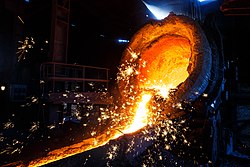
Back باينيت Arabic Beinit BS Bainita Catalan Bainit Czech Bainit German Μπαινίτης Greek Bainita Spanish باینیت Persian Bainiitti Finnish Bainite French

| Steels |
|---|
 |
| Phases |
| Microstructures |
| Classes |
| Other iron-based materials |
Bainite is a plate-like microstructure that forms in steels at temperatures of 125–550 °C (depending on alloy content).[1] First described by E. S. Davenport and Edgar Bain,[2][3] it is one of the products that may form when austenite (the face-centered cubic crystal structure of iron) is cooled past a temperature where it is no longer thermodynamically stable with respect to ferrite, cementite, or ferrite and cementite. Davenport and Bain originally described the microstructure as being similar in appearance to tempered martensite.
A fine non-lamellar structure, bainite commonly consists of cementite and dislocation-rich ferrite. The large density of dislocations in the ferrite present in bainite, and the fine size of the bainite platelets, makes this ferrite harder than it normally would be.[4][5]
The temperature range for transformation of austenite to bainite (125–550 °C) is between those for pearlite and martensite. In fact, there is no fundamental lower limit to the bainite-start temperature.[1][6] When formed during continuous cooling, the cooling rate to form bainite is more rapid than that required to form pearlite, but less rapid than is required to form martensite (in steels of the same composition). Most alloying elements will retard the formation of bainite, though carbon is the most effective in doing so.[7] Aluminium or cobalt are exceptions in that they can accelerate the decomposition of austenite and raise the transformation temperature.[8]
The microstructures of martensite and bainite at first seem quite similar, consisting of thin plates which in low-alloy steels cluster together. This is a consequence of the two microstructures sharing many aspects of their transformation mechanisms. However, morphological differences do exist that require a transmission electron microscope to see. Under a light microscope, the microstructure of bainite appears darker than untempered martensite because the bainite has more substructure.[9]
The hardness of bainite can be between that of pearlite and untempered martensite in the same steel hardness. The fact that it can be produced during both isothermal or continuous cooling is a big advantage, because this facilitates the production of large components without excessive additions of alloying elements. Unlike martensitic steels, alloys based on bainite often do not need further heat treatment after transformation in order to optimise strength and toughness.[10]
- ^ a b Cite error: The named reference
stamwas invoked but never defined (see the help page). - ^ Bhadeshia, H.K.D.H. (2010). "A Personal Commentary on "Transformation of Austenite at Constant Subcritical Temperatures"". Metallurgical and Materials Transactions A. 41 (6): 1351–1390. Bibcode:2010MMTA...41.1351B. doi:10.1007/s11661-010-0250-2.
- ^ Bhadeshia, H.K.D.H. (2023). Theory of transformations in steels (PDF). Taylor and Francis. pp. 1–600. ISBN 978-0-367-51808-0.
- ^ Cite error: The named reference
hardwas invoked but never defined (see the help page). - ^ Durand-Charre, Madeleine (2004). Microstructure of Steels and Cast Irons. Springer. p. 223. ISBN 978-3540209638.
- ^ Bhadeshia, H. K. D. H. (2005). "Hard bainite". In Howe, J. M.; et al. (eds.). Solid Phase Transformations in Inorganic Materials. Vol. 1. pp. 469–484.
- ^ Cite error: The named reference
bain_in_steels_introwas invoked but never defined (see the help page). - ^ Aaronson HI, Domian HA, Pound GM (1966). "Partition of alloying elements between austenite and proeutectoid ferrite or bainite". Metallurgical Society of American Institute of Mining, Metallurgical and Petroleum Engineers – Transactions. 236 (5): 781–96.
- ^ Bhadeshia, H. K. D. H. "Interpretation of steel microstructures". Phase-trans.msm.cam.ac.uk. Retrieved on 2019-03-03.
- ^ Davis, J.R. (1996). ASM Handbook on Carbon and Alloy Steels. ASM International.
© MMXXIII Rich X Search. We shall prevail. All rights reserved. Rich X Search